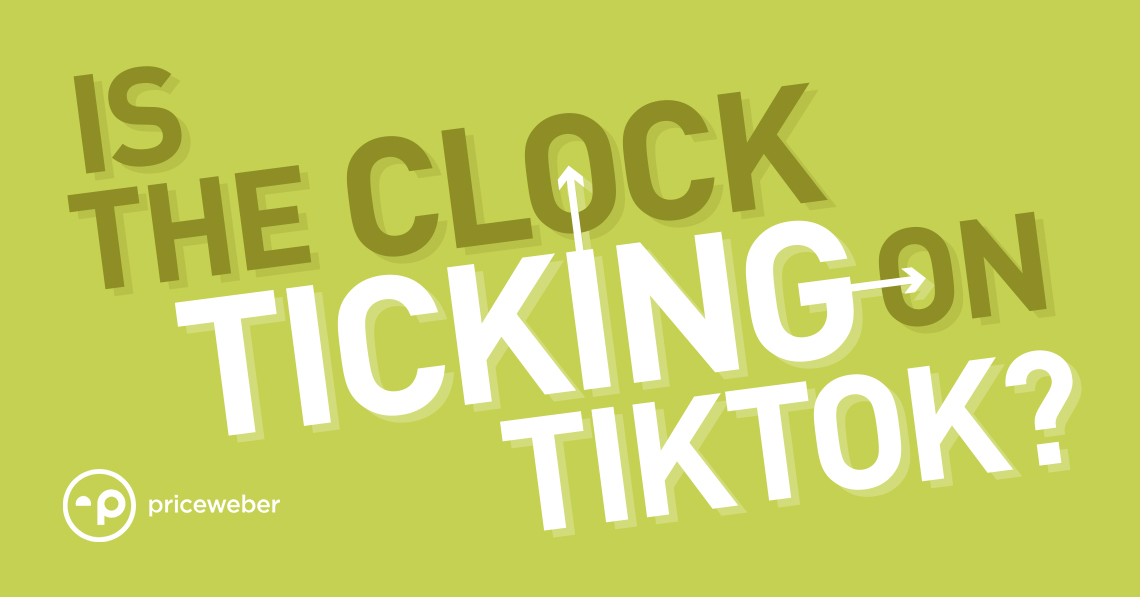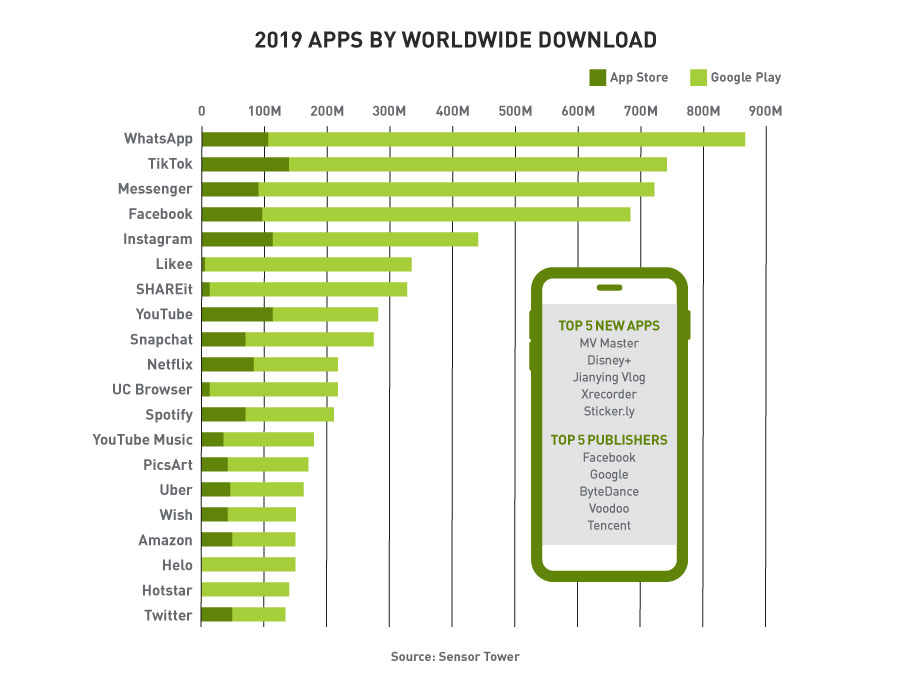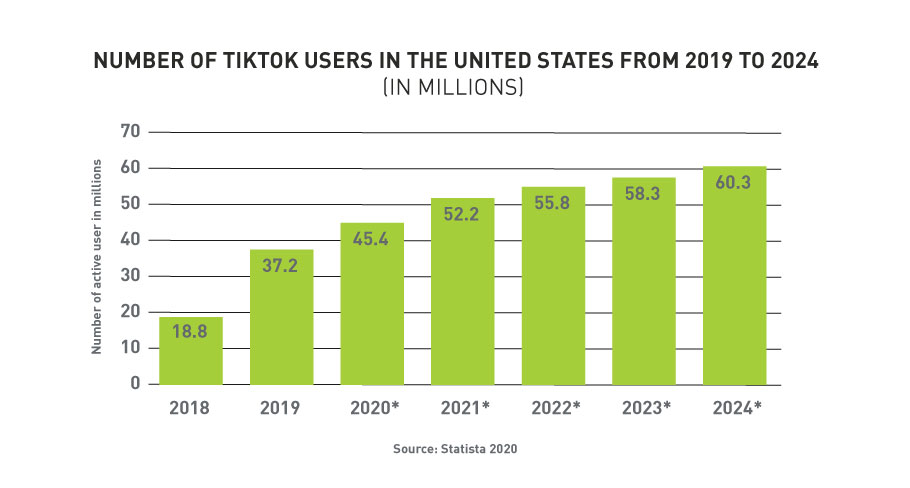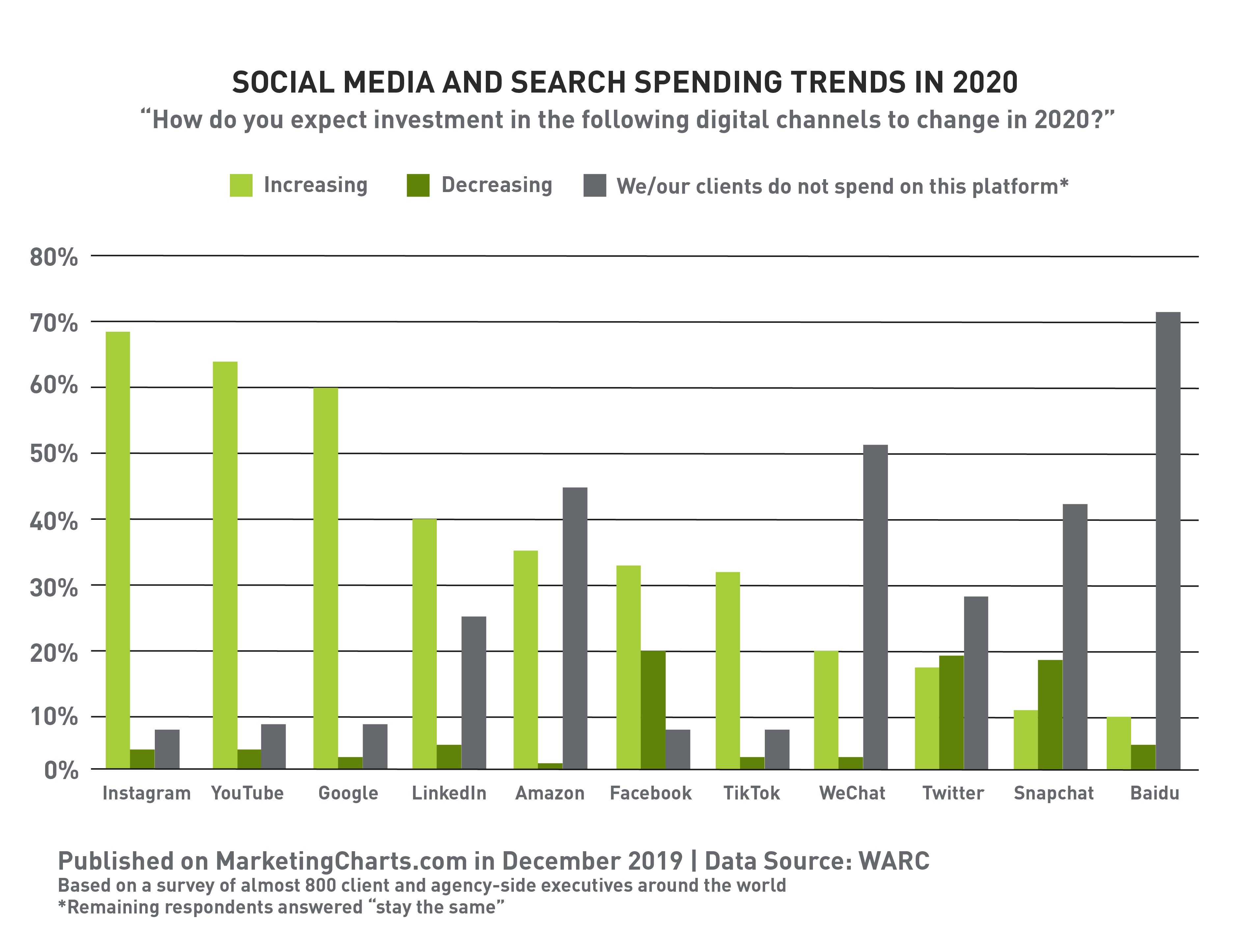While most of the world is in quarantine and practicing social distancing, one social media platform has continued to maintain a rapid growth in downloads, especially in the U.S. According to Sensor Tower’s report, 2019’s second most downloaded app worldwide, TikTok, saw an 18% increase in downloads, tallying the number to 2 million between March 16 and 22, compared to the previous week at 1.7 million. In the first 23 days of March alone, TikTok saw a 27% increase in downloads compared to February, with 6.2 million app downloads. If you are confused by the popularity and sudden take-off by the social video app, you are not alone. We are here to break down who is using the app, what it has to offer for your brand and if you should be on TikTok.
Known as Douyin in China, TikTok was acquired by the Beijing-based company, ByteDance, and released in China in 2016, worldwide in 2017 and the app merged with Musical.ly in 2018. It is a video-sharing networking platform where users can film, edit and publish looping video content that is up to 15 or 60 seconds long. TikTok’s features include music and sounds that users can utilize, or they can upload their own unique sounds, text overlays, different filters and editing transitions. Popular user content features comedic sketches, dance challenges and lip-syncing to songs or sound bites from television and movies. TikTok offers two main feeds of video content, one is “For You,” based on your interests, and the other is “Following,” which is your followers’ content.
Let’s Talk Demographics
It’s not a secret that the app is dominated by Generation Z and younger millennial users, but TikTok continues to see a spike in the older generations. According to TikTok, in October 2019, their largest United States age group was 18-24-year-olds, accounting for 42%, followed by 13-17-year-olds at 27%. It’s about evenly split among gender, but recently the number of U.S. female users has started to increase to about 60%, while 40% are male.
Making Milestones
The quirky and fun app is not just taking off in the U.S. but worldwide. In 2018, TikTok was larger than Instagram and hit a huge milestone, one billion downloads worldwide across iOS and Android, as reported by Sensor Tower. To compare this to other social platforms, Facebook was downloaded 711 million times in 2018 and Instagram was downloaded 444 million times.
According to Ad Age’s report on TikTok’s leaked pitch deck, in March 2019, the app had 800 million monthly active users globally, which was far ahead of Twitter at 330 million and Snapchat at 210 million. However, the U.S. only accounts for 6% of global downloads, but that percentage is increasing as seen in the figure below. Based on eMarketer’s 2020 predictions, TikTok’s U.S. user base will grow 21.9% this year to 45.4 million people.
Who’s Investing?
Although 52% of respondents say they or their clients don’t use TikTok, according to a survey of almost 800 client and agency-side executives worldwide completed by Marketing Charts, 33% of respondents say they will increase their investment in the platform next year (+31% net budget change). This means that more than two-thirds of marketers and agencies that are already investing in TikTok will increase their spend in 2020. How are these agencies making a statement on TikTok? There are different ways to get involved.
How Can My Brand Be on TikTok?
TikTok introduced paid ads to their platform in mid-2019. TikTok’s advertising tools can place ads on the app that direct users to your website or app page with brand takeovers, in-feed ads or top view, as well as promoting hashtag challenges, influencer marketing and branded lenses. TikTok offers targeting based on gender, age and geo-location and the creation of custom audiences by whitelisting and blacklisting profiles. While their targeting appears to offer similar parameters as other platforms, digital executives are skeptical that it is as good as the other more mature platforms. According to DigiDay, TikTok lacks robust targeting and an application programming interface critical for automated buying. It also offers inferior metrics and less precise targeting options compared to the other more mature platforms. Below we will break down what TikTok offers for marketers.
Brand Takeovers – A brand takeover ad can be purchased for several different categories, but only one brand can take over a category for a day. This ad is shown immediately when a TikTok user opens up the app, and it can be redirected to an internal link, another video on TikTok or an external link to another website or app.
In-Feed Ads – In-feed ads are native ads that can be placed at the bottom of organic TikTok videos or as part of the video queue in the feed, depending on the product type. These ads also redirect to your website or app. These ads are a more affordable option than brand takeover ads.
Hashtag Challenges – Hashtag challenges are when a brand can partner with TikTok’s marketing team to create a sponsored hashtag challenge that encourages users to share content on TikTok on your brand’s behalf. These challenges typically last for 6 days, and TikTok claims that 35% of its users participate in challenges and 16% of all the videos on the platform are tied to challenges.
Influencer Marketing – Just like Instagram, there are also TikTok influencers with a large number of followers. These influencers create TikTok content in their own style to influence their followers, which gives an opportunity for brands to partner with an influencer to gain exposure, much like Instagram.
Top View Video – Top view is a video ad that displays once the app opens, allowing for a wider audience reach. While having the same effect as a Brand Takeover, the difference is that videos, such as In-Feed-Videos, can be used as advertising material.
Branded Lenses and Effects – TikTok offers the possibility to create and use 2D, 3D, and Augmented Reality (AR) lenses and effects for the platform. With Branded Lenses, users can interact with the brand and play with it by using their filter, and they promote the consideration to buy and allow users to test products.
Create your own content – The benefit to creating your brand’s own account not only establishes a connection with a younger audience but also gives your brand a more human-like personality. The behind-the-scenes feel allows for a different side of your brand to shine through on TikTok.
Brands That Found Their TikTok Voice
One brand that continues to establish itself on TikTok through that behind-the-scenes feel is the San Diego Zoo. Content features a bird playing Connect Four with a keeper, adorable videos of their baby rhino playing in the mud and their most popular TikTok is of their hippo, Otis, with over 6.4 million likes and over 37.6 million views. The San Diego Zoo is able to connect to their young fans by offering a behind-the-scenes look of your traditional experience at the Zoo.
One of TikTok’s trends is challenges. In 2019, Chipotle was one brand that decided to take advantage of their opportunity and created the #GuacDance challenge in recognition of National Avocado Day. This challenge asked TikTok’s guacamole fans to film themselves dancing to a popular, avocado-centric viral song created by children’s musician, Dr. Jean. The campaign took off and quickly became TikTok’s highest-performing branded U.S. challenge, resulting in 250,000 video submissions during the six-day challenge and Chipotle’s biggest guacamole day ever, with over 802,000 sides of free guac served. Since then, Chipotle has participated in creating other challenges, including the #Boorito challenge for Halloween and #ChipotleLidFlip, which was started by one of their own employees, Daniel Vasquez.
The Washington Post takes first prize for comedic, behind-the-scenes videos and skits while working in their newsroom. One of their video producers, Dave Jorgenson, is the face of their TikTok account and connects to a younger audience with entertainment tailored to their generation. Their approach to speak directly to a specific audience is how they succeed on TikTok and allows the newspaper to establish a new generation of fans, which in return makes their content and brand feel less intimidating.
To TikTok or Not to TikTok?
While TikTok is maintaining steady growth after exploding in downloads in 2019, there are some challenges and concerns around the corner. Since TikTok is a Chinese-owned company, there are concerns with censorship and cyber security. For these reasons, the U.S. military and TSA are banned from using the app. Furthermore, hashtag challenges pose a brand safety risk since they rely completely on user-generated content. Meaning, when a brand creates a sponsored hashtag challenge, they do not have any control of what users will create and publish, similar to Twitter. Lastly, will TikTok die off as quickly as Vine did? Well, it’s possible. Since the app is popular with younger audiences, as Vine once was, the on-trend appeal could fade if videos fail to maintain viewers’ attention. What’s our conclusion? If you are trying to reach a younger audience, specifically Gen Z and younger millennials, then TikTok is a platform you should strongly consider in your social plans, right now at least.
If you are interested in how TikTok could benefit your brand or you’re in need of assistance with your brand’s social media, our team of public relations and social media experts are here to provide assistance. For more information or to schedule a consultation meeting, give us a call at 502-499-4209 or contact us online today.




